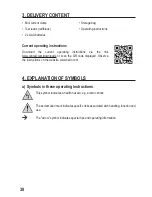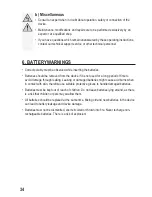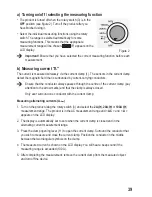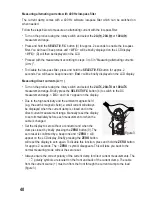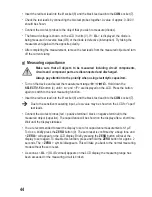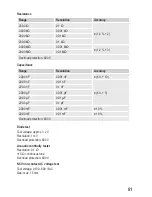
44
• Insert the red test lead into the
V
socket (8) and the black test lead into the
COM
socket (7).
• Check the test leads by connecting the two test probes together. A value of approx. 0.000 V
should be shown.
• Connect the two test probes to the object that you wish to measure (diodes).
• The forward voltage is shown on the LCD in volts (V). If <
OL
> is displayed, the diode is
being measured in reverse bias (UR) or the diode is defective (interruption). Try taking the
measurement again with the opposite polarity.
• After completing the measurement, remove the test leads from the measured object and turn
off the current clamp.
g) Measuring capacitance
Make sure that all objects to be measured including circuit components,
circuits and component parts are disconnected and discharged.
Always pay attention to the polarity when using electrolytic capacitors.
• Turn on the device and select the measurement range
Ω
.
Hold down the
SELECT/V.F.C
button (4) until <
n
> and <
F
> are displayed on the LCD. Press the button
again to switch to the next measuring function.
• Insert the red test lead into the
V
socket (8) and the black test lead into the
COM
socket (7).
Due to the sensitive measuring input, a low value may be shown on the LCD for "open"
test leads.
• Connect the two test probes (red = positive terminal / black = negative terminal) to the
measured object (capacitor). The capacitance will be shown on the display after a short time.
Wait until the display stabilizes.
•
You are recommended to reset the display to zero for capacitance measurements ≤ 1µF.
To do so, briefly press the
ZERO
button (9). The zero reset is confirmed by a beep tone and
<
ZERO
> will appear on the LCD display. Briefly pressing the
ZERO
button will reset the
display to zero again. To disable this function, press and hold the
ZERO
button for approx. 2
seconds. The <
ZERO
> symbol disappears. This will take you back to the normal measuring
mode without the zero reset.
• As soon as <
OL
> (OL=Overload) appears on the LCD display, the measuring range has
been exceeded or the measuring circuit is broken.

